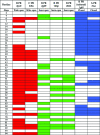Structure of the unbound form of HIV-1 subtype A protease: comparison with unbound forms of proteases from other HIV subtypes
- PMID: 20179334
- PMCID: PMC2827345
- DOI: 10.1107/S0907444909054298
Structure of the unbound form of HIV-1 subtype A protease: comparison with unbound forms of proteases from other HIV subtypes
Abstract
The crystal structure of the unbound form of HIV-1 subtype A protease (PR) has been determined to 1.7 A resolution and refined as a homodimer in the hexagonal space group P6(1) to an R(cryst) of 20.5%. The structure is similar in overall shape and fold to the previously determined subtype B, C and F PRs. The major differences lie in the conformation of the flap region. The flaps in the crystal structures of the unbound subtype B and C PRs, which were crystallized in tetragonal space groups, are either semi-open or wide open. In the present structure of subtype A PR the flaps are found in the closed position, a conformation that would be more anticipated in the structure of HIV protease complexed with an inhibitor. The amino-acid differences between the subtypes and their respective crystal space groups are discussed in terms of the differences in the flap conformations.
Figures







Similar articles
-
High-resolution structure of unbound human immunodeficiency virus 1 subtype C protease: implications of flap dynamics and drug resistance.Acta Crystallogr D Biol Crystallogr. 2008 Jul;D64(Pt 7):754-63. doi: 10.1107/S090744490801278X. Epub 2008 Jun 18. Acta Crystallogr D Biol Crystallogr. 2008. PMID: 18566511
-
Structural insights into the South African HIV-1 subtype C protease: impact of hinge region dynamics and flap flexibility in drug resistance.J Biomol Struct Dyn. 2013 Dec;31(12):1370-80. doi: 10.1080/07391102.2012.736774. Epub 2012 Nov 12. J Biomol Struct Dyn. 2013. PMID: 23140382
-
Structural characterization of B and non-B subtypes of HIV-protease: insights into the natural susceptibility to drug resistance development.J Mol Biol. 2007 Jun 15;369(4):1029-40. doi: 10.1016/j.jmb.2007.03.049. Epub 2007 Mar 24. J Mol Biol. 2007. PMID: 17467738
-
HIV-1 protease flaps spontaneously close to the correct structure in simulations following manual placement of an inhibitor into the open state.J Am Chem Soc. 2006 Mar 8;128(9):2812-3. doi: 10.1021/ja058211x. J Am Chem Soc. 2006. PMID: 16506755 Free PMC article.
-
The early years of retroviral protease crystal structures.Biopolymers. 2010;94(4):521-9. doi: 10.1002/bip.21387. Biopolymers. 2010. PMID: 20593466 Free PMC article. Review.
Cited by
-
Evaluation of novel Saquinavir analogs for resistance mutation compatibility and potential as an HIV-Protease inhibitor drug.Bioinformation. 2014 Apr 23;10(4):227-32. doi: 10.6026/97320630010227. eCollection 2014. Bioinformation. 2014. PMID: 24966525 Free PMC article.
-
Natural Polymorphisms D60E and I62V Stabilize a Closed Conformation in HIV-1 Protease in the Absence of an Inhibitor or Substrate.Viruses. 2024 Feb 2;16(2):236. doi: 10.3390/v16020236. Viruses. 2024. PMID: 38400012 Free PMC article.
-
Spin labeling and Double Electron-Electron Resonance (DEER) to Deconstruct Conformational Ensembles of HIV Protease.Methods Enzymol. 2015;564:153-87. doi: 10.1016/bs.mie.2015.07.019. Epub 2015 Sep 1. Methods Enzymol. 2015. PMID: 26477251 Free PMC article.
-
Elucidating the energetics of entropically driven protein-ligand association: calculations of absolute binding free energy and entropy.J Phys Chem B. 2011 Oct 20;115(41):11902-10. doi: 10.1021/jp204047b. Epub 2011 Sep 26. J Phys Chem B. 2011. PMID: 21899337 Free PMC article.
-
Optimizing the refinement of merohedrally twinned P61 HIV-1 protease-inhibitor cocrystal structures.Acta Crystallogr D Struct Biol. 2020 Mar 1;76(Pt 3):302-310. doi: 10.1107/S2059798320001989. Epub 2020 Mar 2. Acta Crystallogr D Struct Biol. 2020. PMID: 32133994 Free PMC article.
References
-
- Abecasis, A. B., Deforche, K., Bacheler, L. T., McKenna, P., Carvalho, A. P., Gomes, P., Vandamme, A. M. & Camacho, R. (2006). J. Antivir. Ther.11, 581–589. - PubMed
-
- Baldanti, F., Paolucci, S., Ravasi, G., Maccabruni, A., Moriggia, A., Barbarini, G. & Maserati, R. (2008). J. Med. Virol.80, 947–952. - PubMed
-
- Brodine, S. K., Mascola, J. R., Weiss, P. J., Ito, S. I., Porter, K. R., Artenstein, A. W., Garland, F. C., McCutchan, F. E. & Burke, D. S. (1995). Lancet, 346, 1198–1199. - PubMed
-
- Brünger, A. T., Adams, P. D., Clore, G. M., DeLano, W. L., Gros, P., Grosse-Kunstleve, R. W., Jiang, J.-S., Kuszewski, J., Nilges, M., Pannu, N. S., Read, R. J., Rice, L. M., Simonson, T. & Warren, G. L. (1998). Acta Cryst. D54, 905–921. - PubMed
Publication types
MeSH terms
Substances
Grants and funding
LinkOut - more resources
Full Text Sources
Research Materials

